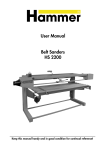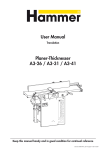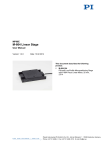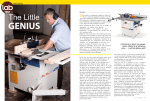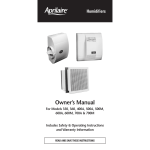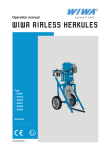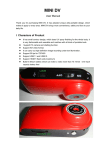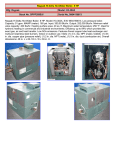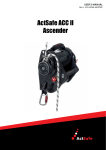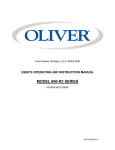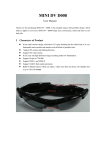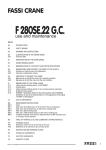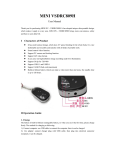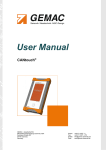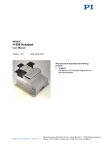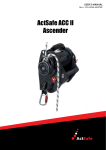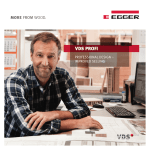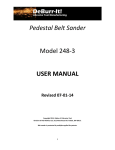Download User Manual Spindle Moulder F3 - FELDER
Transcript
User Manual Spindle Moulder F3 Keep this manual handy and in good condition for continual reference! Spindle Moulder F3 Attention: The machine must be inspected immediately on arrival. If the machine was damaged during transport or if any parts are missing, a written record of the problems must be submitted to the forwarding agent and a damage report compiled. Be sure, also to notify your supplier immediately. For the safety of all personnel, it is necessary to conscientiously study this manual before assembly and commissioning. This manual must be kept in good condition, as it belongs to the machine! Furthermore, keep the manual to hand and in the vicinity of the machine so that it is accessible to personnel when they are using, maintaining or repairing the machine. HAMMER A product of the FELDER GROUP © Felder KG KR-Felder-Str. 1 A-6060 Hall in Tirol Tel.: +43 (0) 5223 5850 0 Fax: +43 (0) 5223 5850 62 Email: [email protected] Internet: www.hammer.at 25. Januar 2007 2 Spindle Moulder F3 Table of Contents Table of Contents 1 General 1.1 1.2 1.3 1.4 1.5 1.6 1.7 ........................................................................................................................... 6 Legend .........................................................................................................6 Information about the manual ..........................................................................6 Liability and warranty.....................................................................................7 Copyright......................................................................................................7 Warranty notice.............................................................................................7 Spare parts ...................................................................................................7 Disposal .......................................................................................................8 2 Safety 2.1 2.2 2.3 2.4 2.5 2.6 2.7 2.8 2.9 ........................................................................................................................... 9 Intended use..................................................................................................9 Manual contents ............................................................................................9 Making changes and modifications to the machine ............................................9 Responsibilities of the owner operator.............................................................10 What is required of personnel .......................................................................10 Work safety ................................................................................................10 Personal safety.............................................................................................11 Hazards arising from the machine..................................................................11 Other risks ..................................................................................................12 3 Declaration of Conformity .................................................................................................. 13 4 Specifications..................................................................................................................... 14 4.1 Dimensions and weight.................................................................................14 4.2 Operation and storage conditions ..................................................................15 4.3 Electrical connection .....................................................................................15 4.4 Drive motor .................................................................................................15 4.5 Particle emission ..........................................................................................15 4.6 Noise emission ............................................................................................16 4.7 Dust extraction .............................................................................................16 4.8 Tools ..........................................................................................................17 5 Setting up the machine....................................................................................................... 18 5.1 Overview ....................................................................................................18 5.2 Accessories .................................................................................................19 5.3 Data plate...................................................................................................24 5.4 Safety devices .............................................................................................25 5.4.1 Safety break switches ...................................................................................25 5.4.2 Spindle moulder guard attachment .................................................................25 5.5 Operation and display elements ....................................................................26 6 Transport, packaging and storage ...................................................................................... 27 6.1 Safety instructions ........................................................................................27 6.2 Transport.....................................................................................................27 6.2.1 Transport locking device................................................................................28 6.2.2 Transport with a crane ..................................................................................28 6.2.3 Transport with a fork lift truck.........................................................................29 6.2.4 Transport with a pallet jack ...........................................................................30 6.2.4.1 Unloading...................................................................................................30 6.2.4.2 Transporting the machine ..............................................................................30 6.2.5 Transport with a rolling carriage ....................................................................31 3 Spindle Moulder F3 Table of Contents 6.3 6.4 6.5 4 Transport inspection......................................................................................31 Packaging ...................................................................................................31 Storage.......................................................................................................32 7 Setup and installation ........................................................................................................ 33 7.1 Safety instructions ........................................................................................33 7.2 Installation ..................................................................................................33 7.3 Assembly ....................................................................................................35 7.3.1 Sliding table................................................................................................35 7.3.2 Spindle moulder guard attachment .................................................................35 7.3.3 Spindle moulder fence ..................................................................................36 7.3.4 Outrigger pipe ............................................................................................36 7.4 Dust extraction .............................................................................................37 7.5 Electrical connection .....................................................................................37 8 Making adjustments and preparations................................................................................ 39 8.1 Safety instructions ........................................................................................39 8.2 Sliding table catch .......................................................................................39 8.3 Crosscut fence on the sliding table .................................................................40 8.4 Crosscut fence on the outrigger ......................................................................40 8.5 Cross stop ...................................................................................................41 8.6 Crosscut fence extension ..............................................................................42 8.7 Safety bar guides.........................................................................................42 8.8 Power feeder ...............................................................................................43 8.9 Changing the tool ........................................................................................43 8.9.1 Preparing to change tooling ..........................................................................43 8.9.2 Preparing the machine to operate ..................................................................44 8.10 Spindle moulder unit ....................................................................................44 8.10.1 Tools ..........................................................................................................44 8.10.2 Adjusting the moulding height/moulding angle ................................................45 8.10.3 Mounting/removing/changing the spindle moulder tool....................................46 8.11 Establishing/setting the speed........................................................................49 8.11.1 Establishing the speed ..................................................................................49 8.11.2 Setting the speed .........................................................................................51 9 Operation ......................................................................................................................... 53 9.1 Safety instructions ........................................................................................53 9.2 Switching on the machine .............................................................................54 9.3 Switching off the machine .............................................................................54 9.4 Emergency stop ...........................................................................................55 9.5 Moving the sliding table................................................................................55 9.6 Work stations ..............................................................................................56 9.7 Working techniques .....................................................................................56 9.7.1 Permitted working techniques.........................................................................56 9.7.2 Prohibited working techniques .......................................................................56 9.7.3 General procedures for authorised working techniques .....................................57 9.7.4 Moulding long sides.....................................................................................57 9.7.5 Moulding profiles.........................................................................................58 9.7.6 Slot and tenon moulding ...............................................................................58 9.7.7 Insert moulding ............................................................................................59 9.7.8 Curve moulding ...........................................................................................60 9.7.9 Moulding with a power feeder.......................................................................61 9.7.10 Moulding with a high velocity spindle.............................................................61 Spindle Moulder F3 Table of Contents 10 Maintenance ..................................................................................................................... 62 10.1 Safety instructions ........................................................................................62 10.2 Maintenance schedule ..................................................................................62 10.3 Cleaning the bearing tracks...........................................................................63 10.4 Lubricating the height and tilting spindle..........................................................63 10.5 Lubricating the spindle moulder socket and tilting segments ...............................64 10.6 Retensioning/replacing the drive belt..............................................................64 10.6.1 Retensioning the drive belt.............................................................................64 10.6.2 Replacing the drive belt ................................................................................65 10.7 Cleaning/changing the dust brush of the outrigger arm ....................................66 10.8 Renewing the sliding table scraper blade (ball cage) ........................................67 10.9 Disassembling the sliding table ......................................................................67 10.10 Assembling the sliding table ..........................................................................68 11 Faults 11.1 11.2 11.3 11.4 11.5 ......................................................................................................................... 70 Safety instructions ........................................................................................70 What to do if a fault develops .......................................................................70 What to do after rectifying the fault ................................................................70 Faults, causes and repairs .............................................................................71 Realign the sliding table ball cage..................................................................71 12 Index ................................................................................................................................ 72 5 Spindle Moulder F3 General 1 General 1.1 Legend Important technical safety instructions in this manual are marked with symbols. These instructions for work safety must be followed. In all these particular cases, special attention must be paid in order to avoid accidents, injury to persons or material damage. Warning: Risk of injury or death! This symbol marks instructions that must be followed in order to avoid harm to one’s health, injuries, permanent impairment or death. Warning: Danger – electric current! This symbol warns of potentially dangerous situations related to electric current. Not observing the safety instructions increases the risk of serious injury or death. Required electrical repairs may only be carried out by a trained electrical technician. Attention: Risk of material damage! This symbol marks instructions which, if not observed, may lead to material damage, functional failures and/or machine breakdown. Attention: This symbol marks tips and information which should be observed to ensure efficient and failure-free operation of the machine. 1.2 Information about the manual This manual describes how to operate the machine properly and safely. Be sure to follow the safety tips and instructions stated here as well as any local accident prevention directives and general safety regulations. Before beginning any work on the machine, ensure that the manual, in particular the chapter entitled “Safety” and the respective safety guidelines, has been read in its 6 entirety and fully understood. This manual is an integral part of the machine and must therefore be kept in the direct vicinity of the machine and accessible at all times. If the machine is sold, rented, lent or otherwise transferred to another party, the manual must accompany the machine. Spindle Moulder F3 General 1.3 Liability and warranty The contents and instructions in this manual were compiled in consideration of current regulations and stateof-the-art technology as well as based on our know-how and experience acquired over many years. This manual must be read carefully before commencing any work on or with this machine. The manufacturer shall not be liable for damage and or faults resulting from the disregard of instructions in the manual. The texts and images do not necessarily represent the delivery contents. The images and graphics are not depicted on a 1:1 scale. The actual delivery contents are dependent on custom-build specifications, add-on options or recent technical modifications and may therefore deviate from the descriptions, instructions and images contained in the manual. Should any questions arise, please contact the manufacturer. We reserve the right to make technical modifications to the product in order to further improve user-friendliness and develop its functionality. 1.4 Copyright This manual should be handled confidentially. It is designated solely for those persons who work on or with the machine. All descriptions, texts, drawings, photos and other depictions are protected by copyright and other commercial laws. Illegal use of the materials is punishable by law. This manual – in its entirety or parts thereof – may not be transferred to third parties or copied in any way or form, and its contents may not be used or otherwise communicated without the express written consent of the manufacturer. Infringement of these rights may lead to a demand for compensation or other applicable claims. We reserve all rights in exercising commercial protection laws. 1.5 Warranty notice The guarantee period is in accordance with national guidelines. Details may be found on our website, www.felder-group.com 1.6 Spare parts Attention: Non genuine, counterfeit or faulty spare parts may result in damage, cause malfunction or complete breakdown of the machine. If unauthorized spare parts are installed in the machine, all warranty, service, compensation and liability claims against the manufacturer and their contractors, dealers and representatives shall be rejected. Use only genuine spare parts supplied by the manufacturer. Attention: The original spare parts that have been authorised for use are listed in a separate spare parts catalogue, enclosed in the documentation package supplied with the machine. 7 Spindle Moulder F3 General 1.7 Disposal If the machine is to be disposed of, separate the components into the various materials groups in order to allow them to be reused or selectively disposed of. The whole structure is made of steel and can therefore be dismantled without problem. This material is also easy to dispose of and does not pollute the environment or jeopard- ise public health. International environmental regulations and local disposal laws must always be complied with. Attention: Used electrical materials, electronic components, lubricants and other auxiliary substances must be treated as hazardous waste and may only be disposed of by specialised, licensed firms. 8 Spindle Moulder F3 Safety 2 Safety At the time of its development and production, the machine was built in accordance with prevailing technological regulations and therefore conforms to industry safety standards. However, hazards may arise should the machine be operated by untrained personnel, used improperly or employed for purposes other than those it was designed for. The chapter entitled “Safety” offers an overview of all the important safety considerations necessary to optimise safety and ensure the safe and trouble-free operation of the machine. Additionally, in order to further minimise risks, the other chapters of this manual contain specific safety instructions, all marked with symbols. Besides the various instructions, there are a number of pictograms, signs and labels affixed to the machine that must also be heeded. These must be kept visible and legible and may not be removed. 2.1 Intended use The HAMMER F3 spindle moulder is only to be used to machine wood and other similar machinable materials. Machining materials other than wood is only permitted with the express written consent of the manufacturer. Operational safety is guaranteed only when the machine is used for the intended purposes. Attention: Any use outside the machine‘s intended purpose shall be considered improper and is therefore not permitted. All claims regarding damage resulting from improper use that are made against the manufacturer and its authorized representatives shall be rejected. The operator shall be solely liable for any damage that results from improper use of the machine. The term “proper use” also refers to correctly observing the operating conditions as well as the specifications and instructions in this manual. The machine may only be operated with original manufacturer parts and accessories. 2.2 Manual contents All those appointed to work on or with the machine must have fully read and understood the manual before commencing any work. This requirement must be met even if the appointed person is familiar with the operation of such a machine or a similar one, or has been trained by the manufacturer. Knowledge about the contents of this manual is a prerequisite for protecting personnel from hazards and avoiding mistakes so that the machine may be operated in a safe and trouble-free manner. It is recommended that the operator requests proof from the personnel that the contents of the manual have been read and understood. 2.3 Making changes and modifications to the machine In order to minimise risks and to ensure optimal performance, it is strictly prohibited to alter, retrofit or modify the machine in any way without the express consent of the manufacturer. All the pictograms, signs and labels affixed to the machine must be kept visible, readable and may not be removed. Pictograms, signs and labels that have become damaged or unreadable must be replaced promptly. 9 Spindle Moulder F3 Safety 2.4 Responsibilities of the owner operator This manual must be kept in the immediate vicinity of the machine and be accessible at all times to all persons working on or with the machine. The machine may only be operated if it is in proper working order and in safe condition. Every time before the machine is switched on, it must be inspected for visible defects and general condition. All instructions in this manual must be strictly followed without reservation. Besides the safety advice and instructions stated in this manual, it is necessary to consider and observe local ac- cident prevention regulations, general safety regulations as well as current environmental stipulations that apply to the operational range of the machine. The operator and designated personnel are responsible for the trouble-free operation of the machine as well as for clearly establishing who is in charge of installing, servicing, maintaining and cleaning the machine. Machines, tools and accessories must be kept out of the reach of children. 2.5 What is required of personnel Only authorized and trained personnel may work on and with the machine. Personnel must be briefed about all functions and potential dangers of the machine. “Specialist staff” is a term that refers to those who – due to their professional training, know-how, experience, and knowledge of relevant regulations – are in a position to assess delegated tasks and recognise potential risks. If the personnel lack the necessary knowledge for working on or with the machine, they must first be trained. Responsibility for working with the machine (installation, service, maintenance, overhaul) must be clearly defined and strictly observed. Only those persons who can be expected to carry out their work reliably may be given permission to work on or with the machine. Personnel must refrain from working in ways that could harm others, the environment or the machine itself. It is absolutely forbidden for anyone who is under the influence of drugs, alcohol or reaction-impairing medication to work on or with the machine. When appointing personnel to work on the machine, it is necessary to observe all local regulations regarding age and professional status. The user is also responsible for ensuring that unauthorised persons remain at a safe distance from the machine. Personnel are obliged to immediately report to the operator any irregularities with the machine that might compromise safety. 2.6 Work safety Following the safety advice and instructions given in this manual can prevent bodily injury and material damage while working on and with the machine. Failure to observe these instructions can lead to bodily injury and damage to or destruction of the machine. Disregard of the safety advice and instructions given in this manual as 10 well as the accident prevention regulations and general safety regulations applicable to the operative range of the machine shall release the manufacturer and their authorised representatives from any liability and from all compensation claims. Spindle Moulder F3 Safety 2.7 Personal safety When working on or with the machine, the following must be strictly observed: Persons with long hair who are not wearing a hairnet are not permitted to work on or with the machine. It is prohibited to wear gloves while working on or with the machine. All jewellery (rings, bracelets, necklaces, etc.) must be removed before starting work on or with the machine. When working on or with the machine, the following must always be worn by personnel: Protective gear (overalls, safety goggles, dust mask, hairnet to contain long hair, etc.) Sturdy, tight-fitting clothing (tear-resistant, no wide sleeves). Protective footwear To protect the feet from heavy falling objects and to prevent slipping on slippery surfaces. Ear protection To avoid hearing damage. 2.8 Hazards arising from the machine The machine has undergone a hazards analysis. The design and construction of the machine are based on the results of this analysis and correspond to state-of-the-art technology. The machine is considered operationally safe when used properly. Nevertheless, there are some residual risks that must be considered. The machine runs with high electrical voltage. Warning! Danger – electric current: Electrical energy can cause serious bodily injury. Damaged insulation materials or defective individual components can cause a life-threatening electrical shock. • Before carrying out any maintenance, cleaning and repair work, switch off the machine and secure it against being accidentally switched on again. • When carrying out any work on the electrical equipment, ensure that the voltage supply is completely isolated. • Do not remove any safety devices or alter them to put them out of commission. 11 Spindle Moulder F3 Safety 2.9 Other risks Warning: Even if the safety measures are followed, there are still certain residual risks that must be considered when working on the machine: • Risk of cutting injuries, especially when changing the tooling. • Danger of injury due to contact with the rotating moulder tool. • Risk of injury due to ejected workpieces. • Risk of injury from workpiece kickback. 12 • Hearing damage as a result of high noise levels. • Health impairments due to the inhalation of airborne particles, especially when working with beech and oak wood. • Risk of squashing, catching, reeling, pushing, cutting or slicing off. Spindle Moulder F3 Declaration of Conformity 3 Declaration of Conformity EG-Declaration of Conformity according to Machine Guidelines 98/37/EG, Appendix II A Manufacturer: Felder KG KR-Felder-Str. 1 A-6060 Hall in Tirol We hereby declare that the machine indicated below, which corresponds to the design and construction of the model we put on the market, conforms with the safety and health requirements as stated by the EC. Product designation: Spindle Moulder Make: HAMMER Model designation: F3 The following EC guidelines were applied: 98/37/EG 73/23/EWG 89/336/EWG - Machine Guidelines - Low-Voltage Guidelines - Electromagnetic Tolerance Guidelines The following harmonised norms were applied: DIN EN 418 DIN EN 848-1 DIN EN 292-1/-2 DIN 33893 DIN EN 60204-1 ÖVE EN 50081-2 ÖVE EN 50082-2 Issuing authority: Prüf- und Zertifizierungsstelle im BG-Prüfzert Fachausschuss Holz Vollmoellerstraße 11 D-70563 Stuttgart Nr. 0392 Conformity with the EC Machine Guidelines certified by: EG-Design Test Certificate No. 981153 according to Machine Guidelines 98/37/EG, Appendix VI This EC Declaration of Conformity is valid only if the CE label has been affixed to the machine. Modifying or altering the machine without the express written agreement of the manufacturer shall render the warranty null and void. Hall in Tirol, 19.01.2007 Johann Felder, Managing Director 13 Spindle Moulder F3 Specifications 4 Specifications 4.1 Dimensions and weight C E A2 A A1 B D Fig. 1: Dimensions F3 Machine Standard Optional Sliding table length (A) 950 mm 1250/2000 mm Sliding table travel distance (A1) 475 mm 765/1475 mm Sliding table travel distance (A2) 651 mm 995/1825 mm 2076 mm 2710/4250 mm Total length (A1+E+A2) Overall width (B) Total height (C) 747 mm 1206 mm Working height (D) 855 mm Machine table length (E) 950 mm Machine table depth 370 mm Weight 280 kg Machine Length 1200 mm Width 800 mm Height 1200 mm Weight 14 350 kg Spindle Moulder F3 Specifications 4.2 Operation and storage conditions Operation/room temperature +10° to +40° C Storage temperature -10° to +50° C. 4.3 Electrical connection Mains voltage 230/400 ±10% V Safeguarding 16 A Triggering characteristic C 4.4 Drive motor The actual values can be found on the data plate. Three-phase alternating current motor Motor voltage Motor frequency ) Motor power S6-40%* System of protection 3 x 400 V 50 HZ 3 (optional 4) kW IP 55 Alternating-current motor Motor voltage Motor frequency ) Motor power S6-40%* System of protection 1 x 230 V 50 or 60 HZ 3 (optional 4) kW IP 55 4.5 Particle emission The machine was tested for particle emissions according to DIN 33893. The Wood Authority ascertained, according to the “Principles for Testing Particle Emissions” (workplace-related particle concentrations) of woodwor- king machines, that the particle emission values for this machine are notably below the currently valid atmospheric limit of 2.0 mg/m³. This is certified by the blue label “BG Wood Particle Tested”. *) S6 = 10 minute operation under load and intermittent service; 40% relative operating factor i.e. the motor may be run at the nominal capacity for 4 minutes and afterwards must run idle for 6 minutes. 15 Spindle Moulder F3 Specifications 4.6 Noise emission The specified values are emission values and therefore do not represent safe workplace values. Even though a relationship exists between particle emission and noise emission levels, an inference cannot be made about whether additional safety measures need to be implemented. Factors which can significantly affect the emission level that presently exists at the workplace include duration of the effect, characteristics of the workspace, and other ambient influences. The permissible workplace values may also differ from country to country. Nevertheless, this information is provided to help the operator better assess hazards and risks. Depending on the location of the machine and other specific conditions, the actual noise emission values may deviate significantly from the specified values. Attention: To keep the noise emission as low as possible, always used sharpened tools and use the correct speed. Ear protection must always be worn; however, such protection cannot be considered a substitute for properly sharpened tools or the correct speed. Acoustic power level according to EN ISO 3746 (Constants 4 dB(A)) Idle 84,5 Decibel (A) Working 90,9 Decibel (A) Emission values at the workplace according to EN ISO 11202 Idle 75,8 Decibel (A) Working 80,7 Decibel (A) An allowance must be made to compensate for tolerances with the specified emission values. K=4 Decibel (A) 4.7 Chip extraction Unit Extractor port diameter Air speed Min. vacuum Min. volume flow (at 20 m/s) 16 Spindle moulder fence Slotting guard 120 mm 120 mm 120 mm 20 m/s 20 m/s 20 m/s 1824 Pa 470 Pa 920 Pa 814+35 m3/h 766 m3/h 790 m3/h Spindle Moulder F3 Specifications 4.8 Chip extraction Warning! Risk of injury! Only use spindle moulder tools, • which have a max. authorised rotation speed higher than that of the spindle moulder, • which conform to DIN EN 847-1 standards and • which have passed the BG test (Employers Liability Insurance Association) and are marked with “MAN”. Spindle moulder Spindle diameter Speed 30 mm 3000, 6000, 8000, 10.000 min-1 High speed spindle rotating speed Dado tooling Max. moulding diameter Spindle moulder tiltable from Spindel height above table Size of spindle table Min. vacuum Min. volume flow Slit hood min. vacuum Slit hood min. volume flow 14.000 min-1 220 (275) mm 220 mm 0–45° 100 mm 950 x 370 mm 470 Pa 766 Cubic meters per hour 920 Pa 790 Cubic meters per hour 17 Spindle Moulder F3 Setting up the machine 5 Setting up the machine 5.1 Overview $ % & / " # ! Fig. 2: Overview !Outrigger arm "Crosscut fence (Outrigger ) #Outrigger table $Sliding table 18 %Spindle moulder fence &Crosscut fence (Outrigger ) /Spindle moulder fence Spindle Moulder F3 Setting up the machine " TYPE : NR. HZ: : PH: V: KW: Baujahr / year of constr. / annee de A: constr. : HALL EUROPE A-6060 AUSTRIA 099 Made by Hammer 090 Fax 05223/45 Tel.: 05223/45 Loretto 42 ! Fig. 3: Overview !Outrigger arm (at 4 kW Specifications - model) "Crosscut fence 5.2 Accessories Table extension 400 mm Order No. 503-137 To safely support long workpieces (assembly instructions „Table extension“). !Table extension ! Fig. 4: Table extension 19 Spindle Moulder F3 Setting up the machine Table extension with foot support Order No. 400-104 To safely support long workpieces (assembly instructions „Table extension“). !Table extension with foot support ! Fig. 5: Table extension with foot support Trimming equipment 1100 Order No. 503-108 (800 x 600 mm) To machine large and heavy panels (assembly instructions „Trimming equipment“). !Trimming equipment ! Fig. 6: Trimming equipment Extension with workpiece roller for the outrigger Order No. 503-132 To correctly place very large or very long panels. !Extension with workpiece roller for the outrigger ! Fig. 7: Extension with workpiece roller for the outrigger 20 Spindle Moulder F3 Setting up the machine Clamp set Order No. 410-190 For the M20 sliding table with ball guiding system. To affix the eccentric clamp onto the sliding table. !Clamp set ! Fig. 8: Clamp set Eccentric clamp Order No. 400-108 and 500-112 Can be used horizontally or vertically for any workpiece. To clamp workpieces securely to the sliding table. !Eccentric clamp ! Fig. 9: Eccentric clamp Rolling carriage with lifting bar Order No. 503-134 500-149 Manoeuvring in the smallest space is possible with the lifting bar and rolling carriage (assembly instructions „Rolling carriage“). !Rolling carriage "Lifting bar " ! Fig. 10: Rolling carriage 21 Spindle Moulder F3 Setting up the machine Tenoning cover Order No. 503-114 ! Tenoning and slotting safely. !Tenoning cover Fig. 11: Tenoning cover Digital clock Order No. 01.1.200 (Display in “mm”) 01.2.200 (Display in “inch”) System handwheel Order No. 12.1.311 The digital clock is built into the height adjustment system handwheel. The digital clock allows precise settings to a tenth of a millimeter (assembly instructions „Digital clock“). 1 2mm/2˚ " !Digital clock "System handwheel ! Fig. 12: Digital clock Safety bar guides Order No. 501-116 ! To protect when moulding profiles. !Safety bar guides Fig. 13: Safety bar guides 22 Spindle Moulder F3 Setting up the machine EURO Curve moulding guard (ring guard) Order No. 400-610 For curved mouldings with an extraction hood for tools up to a diameter of 180 mm. ! !EURO Curve moulding guard (ring guard) Fig. 14: EURO Curve moulding guard (ring guard) Workpiece feed guide for the EURO Curve moulding guard Order No. 400-611 ! Appropriate for tools with a diameter 100 - 160 mm. Smallest possible workpiece inner radius r = 160 mm. !Workpiece feed guide Fig. 15: Workpiece feed guide Attention: See the HAMMER catalogue for other accessories and dust extraction equipment. 23 Spindle Moulder F3 Setting up the machine 5.3 Data plate The data plate is attached to the back of the machine. !Data plate TYPE : NR. HZ: : PH: V: KW: Baujahr / year of constr. / annee de A: constr. : HALL EUROPE A-6060 AUSTRIA Made by Hammer Fax 05223/45099 Tel.: 05223/45090 Loretto 42 ! Fig. 16: Layout of the data plate TYPE : NR. : V: PH: KW: HZ: A: Baujahr / year of constr. / annee de constr. : Maschinen + Werkzeuge für Holz Machines + tools for wood Machines + Outillage pour le bois Made by Hammer AUSTRIA EUROPE A-6060 HALL Loretto 42 Tel.: 05223/45090 Fax 05223/45099 Fig. 17: Data plate 24 The data plate displays the following specifications: • Model designation • Machine number • Voltage • (Phases) • Frequency • Power • Electricity • Year of construction • Manufacturer info Spindle Moulder F3 Setting up the machine 5.4 Safety devices 5.4.1 Safety break switches Ø 120 ø 120 ! The spindle moulder unit will only operate if the safety break switch is actuated (the spindle moulder door is closed ). !Rändelschrauben Fig. 18: Safety break switches 5.4.2 Spindle moulder guard attachment ! " # The spindle moulder guard shields the access to the spindle moulder tool during the moulding process. The spindle moulder guard is mounted to the spindle moulder fence lid on the spindle moulder fence. !Spindle moulder fence "Spindle moulder fence cover #Spindle moulder guard attachment Fig. 19: Spindle moulder guard attachment 25 Spindle Moulder F3 Setting up the machine 5.5 Operation and display elements " # $ ! / * % & Fig. 20: Operation and display elements !Handwheel - Scoring unit height adjustment "Clamping lever - Circular saw angle adjustment #Scale - Circular saw angle adjustment $Handwheel - Circular saw angle adjustment %Green push button - Spindle moulder ON 26 &Red push button - Spindle moulder OFF /Mode switch - Direction of rotation: • • Left Right (Spindle moulder door (Spindle moulder unit door) Spindle Moulder F3 Transport, packaging and storage 6 Transport, packaging and storage 6.1 Safety instructions Warning! There is a risk of injury due to falling parts while transporting, loading or unloading the machine. Attention! Risk of material damage: The machine can be damaged or destroyed if it is subjected to improper handling during transport. For this reason the following safety instructions must be observed: • Never lift loads over a person. • Always move the machine with the utmost care and precaution. • Only use suitable lifting accessories and hoisting devices that have a sufficient load-carrying capacity. • Never transport the machine by putting pressure on any of its projecting elements (e.g. the planer tables). • Consider the machine‘s centre of gravity when transporting it (minimise the risk of it tipping over). • Take measures to prevent the machine from slipping sideways. • Ropes, belts or other hoisting devices must be equipped with safety hooks. • Do not use torn or worn ropes. • Do not use knotted ropes or belts. • Ensure that ropes and belts do not lie against sharp edges. • Transport the machine as carefully as possible in order to prevent damage. • Avoid subjecting the machine to shocks. • When transporting the machine overseas, ensure that the packaging is air-tight and that a desiccant is added to protect the metal parts against corrosion. 6.2 Transport Attention: Transport the machine only according to the enclosed transport and assembly instructions. Never lift the machine by its planer tables. Ropes, belts and chains may only be fastened to the base. The machine is completely assembled when delivered on the pallet. The machine can be transported with a crane, forklift, pallet jack or rolling carriage. 27 Spindle Moulder F3 Transport, packaging and storage 6.2.1 Transport locking device The machine is mounted to the pallet with transport brackets. Remove the transport brackets before moving the machine to the installation location. !Transport brackets ! Fig. 21: Transport locking device 6.2.2 Transport with a crane Only use belts or chains to transport the machine. Attention! Risk of material damage! The machine must not be lifted by the work table, sliding table or base! Only use belts or chains to transport the machine. The F3 spindle moulder is completely assembled upon delivery. Fig. 22: Transport with a crane 28 Spindle Moulder F3 Transport, packaging and storage Guide the belts and chains through the cut-out holes in the machine frame. Fig. 23: Transport with a crane 6.2.3 Transport with a fork lift truck Move the truck’s forks so that they fit into the holes in the machine frame. Fig. 24: Transport with a fork lift truck 29 Spindle Moulder F3 Transport, packaging and storage 6.2.4 Transport with a pallet jack 6.2.4.1 Unloading Use a loading platform similar to that depicted in the picture opposite to unload from the pallet. 1. Push the pallet jack forks into the holes of the machine frame. 2. Unload the machine from the pallet with a pallet jack. ! " !Cut-out hole in the machine frame "Unloading ramp 90 x 90 mm 70 x 70 mm 40 x 40 mm 950 x 750 x 25 mm 90 x 90 mm 70 x 70 mm 40 x 40 mm 950 x 750 x 25 mm Fig. 25: Transport with a pallet jack 6.2.4.2 Transporting the machine Push the pallet jack forks into the holes of the machine frame. Fig. 26: Transport with a pallet jack 30 Spindle Moulder F3 Transport, packaging and storage 6.2.5 Transport with a rolling carriage The rolling carriage is mounted to the machine base. !Rolling carriage "Lifting bar " ! Fig. 27: Transporting the machine with the rolling carriage and lifting bar Attention: The rolling carriage and the lifting bar (option) facilitate the task of transporting the machine. 6.3 Transport inspection Upon arrival, inspect the shipment to ensure that it is complete and has not suffered any damage. If any transport damage is visible, do not accept the delivery or accept it only with reservation. Record the scope of the damage on the transport documents/delivery note. Initiate the complaint process. For all defects that are not discovered upon delivery, be sure to report them as soon as they are recognised as damage claims must be filed within a certain period, as granted by law. 6.4 Packaging If no agreement has been made with the supplier to take back the packaging materials, help to protect the environment by reusing the materials or separating them according to type and size for recycling. Attention! Dispose of the packaging materials in an environmentally friendly way and always in accordance with local waste disposal regulations. If applicable, contract a recycling firm to dispose of the packaging materials. Attention: Help preserve the environment! Packaging materials are valuable raw materials and in many cases, they can be used again or expediently reprocessed or recycled. 31 Spindle Moulder F3 Transport, packaging and storage 6.5 Storage Keep items sealed in their packaging until they are assembled/installed and be sure to observe the stacking and storage symbols on the outside of the packaging. Store packed items only under the following conditions: • Do not store outdoors. • Store in a dry and dust-free environment. • Do not expose to aggressive substances. • Protect from direct sunlight. • Avoid subjecting the machine to shocks. • Storage temperature: -10° to +50° C. • Maximum humidity: 60%. • Avoid extreme temperature fluctuations (condensation build-up). 32 • • • Apply a coat of oil to all bare machine parts (corrosion protection). When storing for a period longer than 3 months, apply a coat of oil to all bare machine parts (corrosion protection). Regularly check the general condition of all parts and the packaging. If necessary, refresh or re-apply the coat of anti-corrosive agent. If the machine is to be stored in a damp environment, it must be sealed in air-tight packaging and protected against corrosion (desiccant). Spindle Moulder F3 Setup and installation 7 Setup and installation 7.1 Safety instructions Warning! Risk of injury: Improper assembly and installation can lead to serious bodily injury or equipment damage. For this reason this work may only be carried out by authorised, trained personnel who are familiar with the operation of the machine and in strict observance of all safety instructions. • Ensure that there is sufficient space to work around the machine. If there is not sufficient distance between the machine and neighbouring machines, walls or other solid objects, the rail-guided workpieces pose a risk during the sawing process. • • Keep the work area orderly and clean. Components and tools that are not put in their correct place or put away may be the cause of accidents! Install the safety equipment according to the instructions and check that it functions properly. Warning! Danger – electric current: Work on electrical fittings may only be carried out by qualified personnel and in strict observance of the safety instructions. Before assembling and installing the machine, check to make sure it is complete and in good condition. Warning! Risk of injury: An incomplete, faulty or damaged machine can lead to serious bodily injury or equipment damage. Only assemble and install the machine if the machine and its parts are complete and intact. Attention! Risk of material damage: Only operate the machine in ambient temperatures from +10° to +40° C. If the instructions are not followed, damage may occur during storage. 7.2 Installation X X Characteristics of the installation site: • Operation/room temperature: +10° to +40° C. • Ensure that the work surface is sufficiently stable and has the proper load-bearing capacity. • Provide sufficient light at the workstation. • Ensure there is sufficient clearance for or from neighbouring workstations. In order that the machine may be operated and maintained properly, it must be set up at least 500 mm away from the wall, parallel to the work direction (measurement „X“). Fig. 28: Space requirements 33 Spindle Moulder F3 Setup and installation 1. Transport the machine to the installation site as instructed in the “Transport” chapter and the enclosed transport or installation instructions. 2. Position the machine with the aid of a spirit level to ensure that the machine functions precisely and operates smoothly. Compensate for uneven floors with the “adjusting screws” or bolster the machine. ! " !Spirit level "Adjusting screws Fig. 29: Positioning the machine 3. If necessary, the machine can be bolted down to the floor with the transport brackets. 4. Remove the oxidation protective layer from all blank machine parts. !Transport brackets ! Fig. 30: Floor mounting 34 Spindle Moulder F3 Setup and installation 7.3 Assembly 7.3.1 Sliding table Remove the transport locking devices between the base and the sliding table, from both sides, before the initial machine start-up. !Locking device ! Fig. 31: Sliding table Attention: Due to transport reasons, the sliding table, depending on its length, may be packaged separately. Depending on the length of the sliding table, two to three additional helpers are required to assemble the table. The sliding table has to be set up before the initial machine start-up. Individual installation instructions are found with the machine or the sliding table. 7.3.2 Sliding table handle unit ! " # 1. Loosen the thumb screws and open the spindle moulder cover. 2. Mount the spindle moulder guard attachment, included in the delivery, with four hexagon screws, shims and nuts to the spindle moulder fence cover. !Thumb screws "Spindle moulder cover #Hexagon screw % $Shims %Nuts $ Fig. 32: Spindle moulder guard attachment Attention: Due to transport reasons, the spindle moulder guard equipment is not assembled upon delivery. 35 Spindle Moulder F3 Setup and installation 7.3.3 Spindle moulder fence ! " # $ !Spindle moulder guard attachment "Thumb screws #Spindle moulder fence $Machine table %Threaded holes % Fig. 33: Spindle moulder fence Assembling: 1. The spindle moulder guard has to be mounted. Mount if required. 2. Position the spindle moulder fence onto the machine table so that both thumb screws can be screwed into the threaded holes. 3. Screw the thumb screw in tightly. 4. Attach the dust extraction hose. Attention: If transported in a container, the spindle moulder fence is mounted and delivered separately from the pallet. In this case, the spindle moulder fence has to be placed onto the machine and fastened securely. 7.3.4 Outrigger pipe 1. Dismantle the safety screw with the nut and the lock nut. 2. Push the outrigger pipe into the bracket arm. 3. Replace the safety screw with the nut and lock nut. " !Thumb screws "Spindle moulder cover #Hexagon screw # ! $ % Fig. 34: Outrigger pipe 36 $Outrigger arm %Nuts Spindle Moulder F3 Setup and installation 7.4 Chip extraction The machine has to be connected to a dust extractor. Unit Extractor port diameter Slotting guard 120 mm 120 mm 120 mm 20 m/s 20 m/s 20 m/s 1824 Pa 470 Pa 920 Pa 814+35 m3/h 766 m3/h 790 m3/h Air speed Min. vacuum Min. volume flow (at 20 m/s) Spindle moulder fence Attention! The dust extraction hoses must be flame retardant. Only use original HAMMER vacuum hoses. • • • The dust extraction system must produce the required vacuum and air flow. Connect the dust extraction system to the machine in such a way so as to operate in unison with the machine. The dust extraction hoses must be electrically conductive and grounded to prevent electrostatic loading. Before putting the machine into operation for the first time, inspect it for defects. 7.5 Electrical connection Warning! Danger – electric current: Work on electrical fittings may only be carried out by qualified personnel and in strict observance of the safety instructions. Attention: Do not open the machine’s switch box unless you have the express consent of the HAMMER service department. Violating this stipulation shall render the right to make claims under the warranty null and void. Characteristics of electrical connections: • The machine must be earthed with electrical conductors. • The voltage fluctuations in the mains supply may not exceed ±10%. • Safeguarding 16 A, Triggering characteristic C. • Power supply cable at least 5x2,5 (Three-phase alternating current motor) or 3x2,5 (Alternating-current motor). • • The power supply cable must be protected against damage (e.g. armoured conduit). The power supply cable must be laid in such a way that it does not overbend or chafe and there is no risk of tripping over it. 37 Spindle Moulder F3 Setup and installation Warning! Danger – electric current: Before hooking up the machine to the power supply, compare the specifications on the data plate with those of the electrical network. Only hook up the machine if the two sets of data correspond to each other. The electrical outlet must have the appropriate socket (for a three phase alternating current motor, CEE). The machine’s power cable is delivered with an open cable end, i.e. without a plug. The operator is responsible for fitting the machine’s power cable with a suitable plug in accordance with any country specific regulations. 38 1. Connect the plug to the power supply. 2. Switch on and let the machine run briefly. 3. While the motor is running, check its direction of rotation. 4. Should a change in the direction of rotation be necessary, switch the two phases on the power cable. Spindle Moulder F3 Making adjustments and preparations 8 Making adjustments and preparations 8.1 Safety instructions Warning! Risk of injury: Improper adjustment and setup work can lead to serious bodily injury or material damage. For this reason this work may only be carried out by authorised, trained personnel who are familiar with the operation of the machine and in strict observance of all safety instructions. • • Before beginning any maintenance work on the machine, switch it off and secure it against accidentally being switched on again. Before commencing any work with the machine, inspect it to ensure that it is complete and in technically good condition. • • • Ensure that there is sufficient space to work around the machine. Keep the work area orderly and clean. Components and tools that are not put in their correct place or put away may be the cause of accidents! Install the safety equipment according to the instructions and check that it functions properly. 8.2 Sliding table catch The sliding table can be locked into the centre position. 1. Rotate the thumb screw by 90° and push in. 2. Move the sliding table slowly into the locked position, until it engages. 3. To unlock, pull out the thumb screw and rotate 90° anti-clockwise. " !Thumb screw "Sliding table ! Fig. 35: Sliding table locking system 39 Spindle Moulder F3 Making adjustments and preparations 8.3 Crosscut fence on the sliding table $ & % # " ! Fig. 36: Assembling the crosscut fence # ! " Fig. 37: Adjusting the end stop 1. Thread the clamping device of the crosscut fence into the groove of the sliding table and move it right up to the stop screw (in the groove). 2. Loosely affix the compressor rod shaft. 3. Set the desired moulding angle (–45° up to +45°): With 90° cuts: • Flip open the end stop on the sliding table. • Place the fence against the end stop. 4. Clamp the stop with the clamping lever. !Clamping device $Compressor rod shaft "Crosscut fence %End stop #Groove &Clamping guide Adjusting: 1. End stop. 2. Loosen the setscrew. 3. Turn the cam lever until a 90° angle is attained (the fence reaches the end stop). 4. Check with a test moulding. 5. Tighten the setscrew. !Setscrew "Cam lever #End stop 8.4 Crosscut fence on the outrigger ! " 1. Thread the locking plate into the outrigger rail. 2. Loosen the thumb screws and position the crosscut fence at the outrigger. 3. Clamp the crosscut fence at the outrigger with the clamping lever. 4. Tighten the thumb screws. & % $ # Fig. 38: Assembling the crosscut fence 40 The crosscut fence can be mounted onto the outrigger on the push side. !Clamping lever "Crosscut fence #End stop $Outrigger %Locking plate &Thumb screws Spindle Moulder F3 Making adjustments and preparations ! & # " Fig. 39: Adjusting the crosscut fence Pivoting: 1. Loosen the clamping lever and thumb screws. 2. Pivot the crosscut fence to the desired position. Fold the end stop back if necessary, so as to be able to pivot the crosscut fence over it. 3. Clamp the clamping lever in place and tighten the thumb screws. 4. Loosen the thumb screws, move the fence profile and retighten the thumb screws in order to compensate the length of the scale when the fence is pivoted. !Clamping lever "Crosscut fence #End stop $Outrigger %Locking plate &Thumb screws 90°-Position: 1. Loosen the clamping lever and thumb screws. 2. Pivot the crosscut fence, until it stops against the end stop. 3. Clamp the clamping lever in place and tighten the thumb screws. 8.5 Cross stop ! " # The cross stop can be pushed onto the crosscut fence in one movement. If required, the end stop can be folded back. 1. Loosen the thumb screw. 2. Move the cross stop to the desired position. The measurement is read from the magnifying lens. 3. Tighten the thumb screw. % $ Fig. 40: Cross stop !Thumb screws "Cross stop #Scale $End stop %Crosscut fence 41 Spindle Moulder F3 Making adjustments and preparations 8.6 Crosscut fence extension ! " The crosscut fence is usually equipped with an extension. 1. Loosen the thumb screw. 2. Move the crosscut fence extension to the desired position. The measurement reading is displayed on the scale on the profile edge of the crosscut fence. 3. Tighten the thumb screw. !Scale "Extension $ # #Thumb screw $Crosscut fence Fig. 41: Crosscut fence extension 8.7 Spindle moulder fence Attention: It is recommended to use safety bar guides (Accessories) when moulding profiles. An end-to-end workpiece support (increased safety) and better results are achieved. Assembling/Disassembling: See separate assembly instructions „Safety bar guides“. ! " # Fig. 42: Safety bar Guide # Sliding: 1. Switch the machine off and ensure that it cannot be switched on again. 2. Loosen the clamping screw. 3. Slide the safety bar guide upwards. 4. Tighten the clamping screws. 5. Check whether the spindle moulder tool is running freely. The spindle moulder tool must not touch the safety bar guides. 6. Check whether the guides are parallel to the machine table. !Clamping screws "Safety bar guides #Guide 42 Spindle Moulder F3 Making adjustments and preparations 8.8 Power feeder Assembling: To attach the power feeder, mount a tilting device to the machine. Adjusting: Separate operating manual „Power feeder“. Fig. 43: Power feeder 8.9 Changing the tool 8.9.1 Preparing to change tooling " 1. Switch the machine off and ensure that it cannot be switched on again. 2. Loosen the thumb screw. 3. Tilt the spindle moulder fence cover and the assembled spindle moulder guard to the back. 4. Loosen the thumb screw on the back. 5. Pull the fence boards apart. ! # # !Spindle moulder cover "Thumb screws #Thumb screws Fig. 44: Preparing to change tooling 43 Spindle Moulder F3 Making adjustments and preparations 8.9.2 Preparing the machine to operate 1. Close the spindle moulder door. 2. Ensure that the spindle moulder guard is correctly assembled, adjusted and tightened. 3. The machine can now be switched on. ! " Fig. 45: Prepare the machine to operate 8.10 Spindle moulder unit 8.10.1 Tools Warning! Risk of injury! Only use spindle moulder tools, • which have a max. authorised rotation speed higher than that of the spindle moulder, • which conform to DIN EN 847-1 standards and • which are marked with “MAN”! 44 !Spindle moulder door "Spindle moulder guard Spindle Moulder F3 Making adjustments and preparations 8.10.2 Adjusting the moulding height/moulding angle Adjusting the moulding height: Adjust the moulding height with the handwheel. • Clockwise: higher • Anti-clockwise: lower Adjust the moulding height only as high as required. # " $ ! Fig. 46: Adjusting the moulding angle Ø 170 170 ø Adjusting the moulding angle: 1. Loosen the clamping lever. 2. Adjust the moulding angle with the handwheel: • Clockwise: towards 90° • Anti-clockwise: towards 45° 3. Read the moulding angle from the scale. 4. Lock the clamping lever. !Handwheel "Clamping lever #Scale $Handwheel The spindle moulder can be lowered in a 90° position under the table for tools with a max. diameter of 170 mm when the tool is clamped and the backing rings are removed. ø 100 max 65 65 mm mm max. Fig. 47: Moulding height Ø ø 100 100 The spindle moulder can be lowered in a 45° position under the table for tools with a max. diameter of 100 mm when the tool is clamped and the backing rings are removed. Fig. 48: Moulding height 45 Spindle Moulder F3 Making adjustments and preparations 8.10.3 Mounting/removing/changing the spindle moulder tool Warning! Risk of injury! The spindle moulder tooling is razor sharp. Handle the spindle moulder tooling carefully, especially when turning the spindle moulder tooling manually. The spindle moulder tooling, in particular the cutting surfaces can be damaged due to improper handling. Therefore do not place the spindle moulder tooling onto the machine table. Store the spindle moulder tooling in special containers or place on hangers. " # ! $ Fig. 49: Spindle moulder guard closed Required tools: • Spanner SW 22 mm • Allen key 8 mm 1. Switch the machine off and ensure that it cannot be switched on again. 2. Loosen the thumb screw. 3. Tilt the spindle moulder fence cover and the assembled spindle moulder guard to the back. 4. Loosen the thumb screw. 5. Pull the guides as far apart as possible. 6. Set the spindle moulder to a 90° angle. 7. Turn the spindle moulder right up to the top. !Thumb screws "Spindle moulder guard attachment #Flat-head screw $Thumb screw " # % Fig. 50: Spindle moulder guard is open 46 !Spindle moulder guard attachment "Spindle moulder fence cover #Guide Spindle Moulder F3 Making adjustments and preparations ! " # $ 8. Hold the spindle moulder cap with the spanner SW (22 mm). 9. Loosen the socket head cap screw with the Allen key (8 mm), in a clockwise direction, and remove. 10. Remove the spindle moulder cap and collar. 11. Remove the spindle moulder tooling when changing or removing the tools. 12. Remove dust and shavings from the spindle moulder. !Spindle moulder cap "Socket head cap screw #Spindle moulder collar $Spindle moulder Fig. 51: Spindle moulder Pay attention to the correct rotational direction of the spindle moulder tool. The workpiece to be machined, may only be moulded in the opposite direction. Fig. 52: Spindle moulder direction of rotation Attention: Only use original manufacturer tools! ! " # $ % # Fig. 53: Installing the spindle moulder tool 13. Changing or fitting in tools: • Place the spindle moulder tool as low as possible onto the spindle moulder so as to avoid vibrations. • Place as many spindle collars as are required to achieve sufficient clamping space (approx. 8 mm) between the spindle moulder cap and the spindle moulder. Tool removal: Mount all the spindle collars. Take note that there is sufficient clamping space (approx. 8 mm) between the spindle moulder cap and the spindle moulder. !Socket head cap screw "Spindle moulder cap #Spindle moulder collar $Spindle moulder %Spindle moulder tool 47 Spindle Moulder F3 Making adjustments and preparations 14. Fit on the spindle moulder cap and socket head cap screw. 15. Hold the spindle moulder with the spanner SW (22 mm). 16. Tighten the socket head cap screw with the Allen key (8 mm), in an anti-clockwise direction. Fig. 54: Incorrect tooling fitting Warning! Minimum tightening torque: 30 Nm! ! " # % $ 17. Close as much of the table opening with backing rings. 18. Adjust the guides according to the tooling. 19. Tilt the spindle moulder fence lid and the mounted spindle moulder guard to the front. 20. Screw on the spindle moulder fence lid tightly with the thumb screws. 21. Establish the speed. 22. Set the speed. !Spindle moulder guard attachment "Spindle moulder fence cover #Guide $Backing rings %Thumb screws Fig. 55: Spindle moulder guard is open 48 Spindle Moulder F3 Making adjustments and preparations 8.11 Establishing/setting the speed mm ø 25,4 mm ø 25,4 mm mm mm mm ø 30 mm ø 30 mm mm mm mm mm 8.11.1 Establishing the speed Fig. 56: Diagrams - Establishing the speed 49 Spindle Moulder F3 Making adjustments and preparations 1. Select the appropriate diagram depending on the spindle diameter and type of tools (aluminium or steel tools). 2. Determine the maximum rotating speed (limit value) from the appropriate diagram, depending on the diameter of the tool and the cutting length. Attention: A higher maximum speed is allowed with aluminium tooling (limit value). Use the correct diagram to obtain the accurate speed. Warning! Risk of material damage! Do not exceed the limit value obtained from the diagram! ! 300 280 250 220 200 180 160 140 125 100 80 69 63 57 75 50 67 44 59 52 65 42 52 42 " ø mm 12 11 10 8,5 8 7 6 5,5 5 4 3 3. Determine the correct spindle speed for the machine from the sticker on the door. Depending on the tooling diameter and the established maximum speed (limit value) use the information on the sticker to determine whether the spindle speed setting is too high or too low for the tooling diameter. The cutting speed should always be between 40 and 75 m/s. 4. Set the obtained spindle speed. !Tools diameter "Cutting speed #Spindle speed # Fig. 57: Tools diameter Warning! Risk of injury! Risk of material damage! Cutting speed: • smaller 40 m/s kickback risk • larger 75 m/s tool breakage risk 50 Spindle Moulder F3 Making adjustments and preparations 8.11.2 Setting the speed 1. Switch the machine off and ensure that it cannot be switched on again. 2. Loosen the clamping lever. 3. Set the spindle moulder to 90° with the handwheel. 4. Bring the spindle moulder into the lowest position with the handwheel. 5. Loosen the screw and open the door. 6. Loosen the belt tensioning screw. # $ ! % " !Door "Screw #Handwheel $Clamping lever %Handwheel Fig. 58: Spindle moulder unit Warning! Risk of material damage! Do not over-tension the drive belt. Only tighten the belt tensioning screw until sufficient power transmission is guaranteed. 7. Shifting the belt: Reducing speed: • Lay the belt around the motor pulley and then around the spindle moulder. Increasing speed: • Lay the belt around the spindle moulder and then around the motor pulley. 8. Tighten the belt tensioning screw. $ ! " # !Motor pulley "Belt tensioning screw #Belt $Spindle moulder Fig. 59: Setting the speed 51 Spindle Moulder F3 Making adjustments and preparations 9. Close the door and lock with the screw. !Screw "Door " ! Fig. 60: Spindle moulder unit 8.12 Outrigger table Assembling the outrigger table: 1. Place the outrigger table onto the support shaft. 2. Place the outrigger table onto the support arbor. 3. Affix with the clamping lever. ! Disassembling the outrigger table: 1. Loosen the clamping lever. 2. Unhook the outrigger table from the support arbor and the sliding table. " $ # Fig. 61: Assembling the outrigger table 52 !Clamping lever "Groove #Outrigger table $Support arbor Spindle Moulder F3 Operation 9 Operation 9.1 Safety instructions Warning: Risk of injury: Improper operation may lead to severe bodily injury or material damage. For this reason this work may only be carried out by authorised, trained personnel who are familiar with the operation of the machine and in strict observance of all safety instructions. Before starting work: • Before assembling and installing the machine, check to make sure it is complete and in good condition. • Ensure that there is sufficient space to work around the machine. • Keep the work area orderly and clean. Components and tools that are not put in their correct place or put away may be the cause of accidents! • Ensure that all safety devices have been properly installed. • Adjustments to the machine or tool replacement may only be conducted once the machine has stopped. • Only clamp authorised tools to the machine. • Tighten the saw blade and scoring blade clamping screws. • Set the splitter correctly. • Only work with sharp tools. This reduces the kickback risk especially with slotted blades. • Adapt the speed to the tooling. • Install the dust extraction system according to the instructions and test its function. • Only process workpieces that can be safely placed on the machine and guided. • Carefully inspect workpieces for foreign matter (nails, screws) which might impair processing. • Support long workpieces with additional surface equipment (e.g.: Table extensions, Roll supports). • Ensure that the tool turns freely. • Keep tools for handling short and narrow workpieces close at hand. • Before switching on the machine, always check to make sure that there are no other persons in the immediate vicinity of the machine. During operation: • Never place your hands on the workpiece by leaning over the circular saw and/or the scoring unit. • When changing to another workpiece or if a malfunction occurs, first switch off the machine and then secure it against being switched on again accidentally. • Do not switch off, circumvent or decommission protective and safety devices during operation. When working on or with the machine, the following must be strictly observed: • Persons with long hair who are not wearing a hairnet are not permitted to work on or with the machine. • It is prohibited to wear gloves while working on or with the machine. All jewellery (rings, bracelets, necklaces, etc.) must be removed before starting work on or with the machine. When working on or with the machine, the following must always be worn by personnel: • Sturdy, tight-fitting clothing (tear-resistant, no wide sleeves). • Protective footwear that protects the feet from heavy falling objects and prevents sliding on slippery floors. • Ear protection to protect against loss of hearing. Attention: Risk of material damage: Only operate the machine in ambient temperatures from +10° to +40° C. If the instructions are not followed, damage may occur during storage. Warning: Danger – electric current: Work on electrical fittings may only be carried out by qualified personnel and in strict observance of the safety instructions. 53 Spindle Moulder F3 Operation 9.2 Switching on the machine Warning: Risk of injury due to insufficient preparation! It is only permitted to switch on the machine if, for the work at hand, the required preconditions are fulfilled and any preliminary work is completed. For this reason the instructions for adjusting, fitting and operating (see the corresponding chapters) must be read before switching on the machine. 1. Release the main switch safety mechanism and switch on (Position „I“). 2. Place/set the mode switch to: • Left = Anti-clockwise rotation or • Right = Clockwise rotation. ! " Only with alternating current: 3. Press and hold down the green push button. 4. Release the push button once the machine has reached the maximum rotational speed. !Green push button "Mode switch Fig. 62: Push button Attention! Risk of material damage! Improper operation may cause damage to the machine Do not activate the green push button whilst the machine is in operation! 9.3 Switching off the machine 1. Push and release the red push button. 2. Switch off (Position “0”) the main switch and secure. !Main switch ! Fig. 63: Push button 54 Spindle Moulder F3 Operation 9.4 Emergency stop Switch the main switch to the “0” setting. The machine is stopped automatically. !Push button TYPE : NR. HZ: : PH: V: KW: Baujahr / year of constr. / annee de A: constr. : HALL EUROPE A-6060 AUSTRIA 99 Made by Hammer 90 Fax 05223/450 Tel.: 05223/450 Loretto 42 ! Fig. 64: Push button 9.5 Moving the sliding table To move the sliding table, use: • the side hand lever or • the crosscut fence. !Side hand lever ! Fig. 65: Moving the sliding table 55 Spindle Moulder F3 Operation 9.6 Work stations Warning: Risk of injury! • Risk of injury due to flying workpieces and workpiece parts (e.g. cutting tools, branches, trimmings). • • Always work from right to left in front of the machine. Exception: for special tasks (e.g. curve moulding with clockwise moulding direction). Operate from left to right. • Slotting, tenoning and panel-raising (using a slot and tenon guard) Using a high velocity spindle Using a power feeder Fig. 66: Work stations/Work positions 9.7 Working techniques 9.7.1 Permitted working techniques Only the following work techniques are allowed with the spindle moulder: • Profile and long side moulding (using the spindle moulder fence) • Insert moulding • Curve moulding (using the spindle moulder fence) • • 9.7.2 Prohibited working techniques The following working techniques are strictly forbidden when using the spindle moulder: • All working techniques without the use of a spindle moulder fence, curve moulding fence or slotting cover • Synchronous moulding (the rotational moulding direction corresponds to that of the feeding direction) 56 • • • Use of higher speed, and/or a larger diameter than appears in the speed diagram Slotting with circular saw blades Use of tools with larger tool bores by using drill sleeves Spindle Moulder F3 Operation 9.7.3 General procedures for authorised working techniques 1. Switch the machine off before starting to operate. 2. Ensure there are sufficient extension options (accessories). 3. Keep handling auxiliaries at hand: • Pushing stick; wood with holding magnets (Order No.: 11.2.012), • Pushing stick; plastic (Order No.: 11.0.010), • Pushing grip (Order No.: 11.1.009). 4. Set the moulding height and/or moulding angle. 5. If required, and depending on the previous machine use: • Remove the saw guard. • Set the spindle moulder to a 90° angle and move to the lowest position. • Ensure that the saw blade does not protrude over the top edge of the machine table. • Assemble the spindle moulder tool. • Disassemble the circular saw fence. • Mount the spindle moulder guard. 6. The vacuum system must be connected. 7. Only switch on the spindle moulder once the workpiece has been positioned correctly and is ready to be cut. 8. Feed the workpiece constantly past the spindle moulder tool keeping the fingers balled into a fist. 9. Use a push stick at the end of the moulding process if necessary. 10. Switch the machine off once finished moulding. 9.7.4 Moulding long sides " ! 1. Take note of general procedures for authorised working techniques. 2. Set the detachable spindle fence guide exactly on the diameter of the spindle moulding tool. 3. Set the depth of cut with the feeding spindle fence guide. 4. Set the moulding height and/or moulding angle. 5. Press the workpiece against the fence and spindle table and feed past the spindle moulder tool with fingers and thumbs balled into a fist. 6. If you are not going to continue working, switch off the machine and secure it against being turned on again accidentally. Fig. 67: Moulding long sides !Fence guide "Fence guide Warning: Risk of injury! Use a push stick or push block at the end of the workpiece. 57 Spindle Moulder F3 Operation 9.7.5 Moulding profiles Numerous profiles are possible when combining the angle and height adjustment with the diverse moulding cutter heads and profile knifes. Moulding profiles corresponds to moulding long sides. Fig. 68: Moulding profiles 9.7.6 Slot and tenon moulding " ! # Fig. 69: Slot moulding 1. Take note of general procedures for authorised working techniques. 2. Slotting and tenoning guard and tenoning plate (Accessories). 3. Using an eccentric clamp, tighten the workpiece onto the tenoning plate close to the circle of cut. 4. Place the slotting guard as close as possible to the workpiece. 5. Set the correct low speed. 6. Use the sliding table to feed the workpiece past the spindle moulder tool. 7. If you are not going to continue working, switch off the machine and secure it against being turned on again accidentally. !Slotting guard "Eccentric clamp #Tenoning plate 58 Attention: A ply-wood board has to be placed behind the workpiece so that it does not tear when slotting. Spindle Moulder F3 Operation 9.7.7 Insert moulding 1. Take note of general procedures for authorised working techniques. 2. The guides of the spindle moulder fence must be aligned. Set if required. 3. Lock the sliding table. 4. Move the crosscut fence on the sliding table right up to the guide of the spindle moulder fence and clamp in place. Fig. 70: Insert moulding Attention: This step is necessary if the whole length of the workpiece is not machined. 5. Leave the workpiece against the crosscut fence and dip carefully into the rotating tool. 6. Once the workpiece is located against the spindle moulder fence guide, press the workpiece against the fence and the spindle table, and feed past the spindle moulder tool with fingers and thumbs balled into a fist. 7. If you are not going to continue working, switch off the machine and secure it against being turned on again accidentally. Fig. 71: Insert moulding Attention: The crosscut fence serves as a kickback guard. Another appropriate kickback guard may also be used. 59 Spindle Moulder F3 Operation 9.7.8 Curve moulding " EURO Curve moulding guard (ring guard) (Order No.: 400610) and use a template made from a 16 mm ply-wood board. ! ! # $ * / Fig. 72: Curve moulding & %$ Use the appropriate guide rings depending on the tooling diameter. 1. Take note of general procedures for authorised working techniques. 2. Fasten the EURO curve moulding guard to the machine table using both screws. 3. Set the start batten to the height of the guide ring with a gap of 1 to 2 mm. 4. Adapt the curve moulding guard to the workpiece using the thumb screws. 5. Loosen the thumb screws, place the brushes on the foremost point of the guide ring and tighten the thumb screws again. !Thumb screw #Thumb screw %Brushes /Guide ring "Thumb screw $Screws &Start batten *Curve moulding guard Attention: This operation (also known as curve shaping) is used to trim curved workpieces. 6. Clamp the workpiece to the template (e.g. with the clamping levers). 7. If you are not going to continue working, switch off the machine and secure it against being turned on again accidentally. Fig. 73: Template 60 Spindle Moulder F3 Operation 9.7.9 Moulding with a power feeder 1. Take note of general procedures for authorised working techniques. 2. If required, set up the power feeder. 3. Adjust the power feeder. 4. If you are not going to continue working, switch off the machine and secure it against being turned on again accidentally. Fig. 74: Moulding with a power feeder 9.7.10 Moulding with a high velocity spindle In addition, the machine can be equipped with a high velocity spindle. 1. Take note of general procedures for authorised working techniques. 2. Mount the spindle moulder fence or the EURO Curve moulding guard as a protective device. 3. Press the workpiece against the fence and spindle table and feed past the spindle moulder tool with fingers and thumbs balled into a fist. 4. If you are not going to continue working, switch off the machine and secure it against being turned on again accidentally. Fig. 75: High velocity spindle Attention: The high velocity spindle is especially designed for dovetail or duplicate mouldings. Only use original manufacturer tools. 61 Spindle Moulder F3 Maintenance 10 Maintenance 10.1 Safety instructions Warning! Risk of injury: Improper maintenance can cause serious injury or damage. For this reason this work may only be carried out by authorised, trained personnel who are familiar with the operation of the machine and in strict observance of all safety instructions. • Before beginning any maintenance work on the machine, switch it off and secure it against accidentally being switched on again. • Ensure that there is sufficient space to work around the machine. • Keep the work area orderly and clean. Components and tools that are not put in their correct place or put away may be the cause of accidents! • Following the maintenance work, re-install the guards and check that they are functioning properly. Warning! Danger – electric current: Work on electrical fittings may only be carried out by qualified personnel and in strict observance of the safety instructions. 10.2 Maintenance schedule Interval Daily Component Machine Table surfaces Bearing tracks Weekly Every 40 operating hours, at least once a month Monthly Every quarter (or sooner should the machine become stiff) Every 6 months If worn out 62 Dust extractor Machine Height and tilting spindle Drive belt Task to accomplish Remove dust and shavings. Remove dust and shavings. Remove any resin residue. Remove dust and shavings. Remove any resin residue. Check for defects. Clean thoroughly. Lubricating. Dust extractor Check and if required, retension or change. Check efficiency. Dust brush (outrigger arm) Scraper (roller cage) Clean and if necessary, renew. Renew. Attention: Cleaning and care products are available as accessories (HAMMER-catalogue). Spindle Moulder F3 Maintenance 10.3 Cleaning the bearing tracks 1. Switch the machine off and ensure that it cannot be switched on again. 2. Remove dust and shavings from the bearing tracks. 3. Remove any resin residue: resin remover Order No. 10.0.022 (0,5 l) or 10.0.023 (1,0 l) !Bearing tracks ! Fig. 76: Cleaning the bearing tracks 10.4 Lubricating the height and tilting spindle " ! 1. Switch the machine off and ensure that it cannot be switched on again. Lubricating the height spindle: 2. Turn the spindle moulder to the uppermost position. 3. Through the frame opening, lubricate the height spindle with regular machine grease. 4. Turn the spindle moulder first to the lowest and then to the uppermost position. Fig. 77: Height spindle/Tilting spindle Lubricating the tilting spindle: 5. Tilt the spindle moulder into a 45° position. 6. Through the frame opening, lubricate the tilting spindle with regular machine grease. 7. Tilt the spindle moulder into a 90° position and then again into a 45° position. !Height spindle "Tilting spindle 63 Spindle Moulder F3 Maintenance 10.5 Lubricating the spindle moulder socket and tilting segments ! " # 1. Switch the machine off and ensure that it cannot be switched on again. 2. Move the spindle moulder right to the top and tilt to a 90° position. 3. Remove chips, dust and grease residues. 4. Lubricate the left and right tilting segments and the spindle moulder socket with machine grease. 5. Move the spindle moulder, repeatedly, up and down. 6. Move the spindle moulder, repeatedly, between the 45° and 90° positions. 7. If required, lubricate again. !Spindle moulder socket "Right #Left Fig. 78: Spindle moulder socket 10.6 Retensioning/changing the drive belt 10.6.1 Retensioning the drive belt 1. Switch the machine off and ensure that it cannot be switched on again. 2. Loosen the screw and open the door. ! " Fig. 79: Drive belt 64 !Door "Screw Spindle Moulder F3 Maintenance 3. Use the belt-tensioning screw to tension the drive belt. 4. Close the door and lock with the screw. ! !Clamping screw "Drive belt " Fig. 80: Spindle moulder unit Attention! Risk of material damage! Do not over-tension the drive belt. Turn the belt-tensioning screw only until the drive belt is sufficiently tensioned to transmit power effectively. 10.6.2 Replacing the drive belt 1. Switch the machine off and ensure that it cannot be switched on again. 2. Loosen the screw and open the door. ! " !Door "Screw Fig. 81: Drive belt 65 Spindle Moulder F3 Maintenance 3. Turn the belt tensioning screw to the left to loosen old belts. 4. Remove old belts. 5. Hook the new belts in: • Hook the belts around the motor pulley first. • Pull the motor pulley with the belt forwards. • Hook the belt onto the spindle moulder. 6. Retension the belt. $ !Motor pulley "Belt tensioning screw # ! " #Belt $Spindle moulder Fig. 82: Hook the belt in 10.7 Cleaning/changing the dust brush of the outrigger arm ! " # $ % Fig. 83: Dust brush (outrigger arm) 66 1. Clean the dust brush and check if in good condition. 2. Renew the dust brush if it is worn out, that is if the outer slider is no longer cleaned: • Loosen the socket head cap screw and washer from the outrigger arm. • Remove the worn out dust brush. • Insert a new dust brush. • Screw the dust brush onto the outrigger arm with a socket head cap screw and washer. !Outrigger arm "Socket head cap screw #Washer $Dust brush %Outer slider Spindle Moulder F3 Maintenance 10.8 Renewing the sliding table scraper (ball cage) 1. Switch the machine off and ensure that it cannot be switched on again. 2. Disassemble the sliding table. 3. Remove the wheel bolts and worn scrapers. 4. Mount the new scrapers and tighten with the wheel bolts. 5. Assemble the sliding table. " !Bolts "Scraper ! Fig. 84: Ball cage 10.9 Disassembling the sliding table ! % On the base, on the side from which the sliding table should be pushed from the base: 1. Remove the fillister head screws and the base cover. 2. Remove the socket head cap screws and washers. 3. Remove the flat head screws. & " !Base "Fillister-head screws #Socket head cap screw # $Cover %Washer &Flat head screws $ Fig. 85: Base BO ) * / BL Fig. 86: Sliding table On the underside of the opposite side of the sliding table: 4. Remove the fillister head screws and the sliding table cover. 5. Remove the flat head screws. 6. Counter hold the hexagon nut and loosen the flat head screw. 7. Remove the hexagon nut, flat head screw and bearing shaft. BN BM /Cover (Sliding table )Bearing shaft BLFillister head screw BMFlat-head screw BNFlat-head screw BOHexagon nut 67 Spindle Moulder F3 Maintenance On the side from which the sliding table should be pushed from the base: 8. Pull the sliding table from the base. !Base "Sliding table " ! Fig. 87: Base/Sliding table 10.10 Assembling the sliding table 1. Ensure that the ball cage scrapers sit tightly. 2. Ensure that there are no balls in the ball cage missing. 3. Move the cage plate with the ball cages in the middle on the guides of the base. ! !Base "Ball cages #Cage plate $Scraper $ # " Fig. 88: Roller cage Attention: The number of ball cages and the length of the cage plate depend on the dismantled sliding table. 4. Thread the sliding table onto the ball cages. 5. Slide the sliding table a few centimeters over the guidings of the base. 6. Push the sliding table further onto the base; make sure that the following ball cages are threaded cleanly between the base and the sliding table. 7. Slide the sliding table completely onto the base. !Base "Sliding table ! Fig. 89: Base roller cage 68 " Spindle Moulder F3 Maintenance ! " On the base: 8. Screw the flat head screws in. 9. Screw in the socket head cap screw with washers. 10. Screw the base cover on with fillister head screws. # $ !Base "Washers #Socket head cap screw # $Fillister head screw %Cover &Flat-head screw % Fig. 90: Base ! " On the opposite side on the sliding table: 11. Screw the bearing shaft on with flat head screw and the hexagon nut. 12. Screw the flat head screws in. 13. Screw the sliding table cover on with fillister head screws. & % # $ / !Cover "Fillister head screw #Sliding table $Flat-head screw %Bearing shaft &Hexagon nut /Flat-head screw Fig. 91: Sliding table 69 Spindle Moulder F3 Faults 11 Faults 11.1 Safety instructions Warning! Risk of injury: Repairing faults incorrectly can result in personal injury or damage the machine. For this reason this work may only be carried out by authorised, trained personnel who are familiar with the operation of the machine and in strict observance of all safety instructions. Warning! Danger – electric current: Work on electrical fittings may only be carried out by qualified personnel and in strict observance of the safety instructions. 11.2 What to do if a fault develops Stricktly speaking: • In the event of a breakdown which creates danger for either personnel or equipment, or occupational safety, switch the machine off immediately with the main switch. • Also disconnect the machine from the mains and secure it from being switched on again. 11.3 What to do after rectifying the fault Warning! Risk of injury! Before switching the machine back on: • the fault and its cause are professionally repaired, • all safety measures have been assembled according to the regulations and are faultless, • individuals are not located in the danger area of the machine. 70 • • Inform those responsible for machine faults immediately. Type and extent of fault should be determined by an authorised professional, as well as the cause and repair. Spindle Moulder F3 Faults 11.4 Faults, causes and repairs Problem Moulder spindle is not rotating. Moulder spindle is only rotating very slowly despite correct speed setting. The belt squeals upon the spindle moulder being switched on, or alterna tively when the spindle moulder starts to operate. The machine is not running. The full cutting length of the sliding table is not achieved. Cause Repair Spindle moulder unit drive belt is torn. Renew the drive belt. Drive belt not enough tension. Retension the drive belt. The speed has not been selected correctly. Select the speed according to the diagram. Drive belt too loose. The main switch is off. The spindle moulder door is open. The sliding table ball cage is misaligned. Retension the drive belt. Switch on the main switch. Close the spindle moulder door. Realign the sliding table ball cage. 11.5 Aligning the sliding table ball cage The ball cage can, over time, become misaligned due to small sliding table travelling distances. The full cutting length will, thus, not be achieved. Repair: 1. Move the sliding table past the resistance into the dead-centre position and up to the stop. 2. Then, move the sliding table continuously in the other direction to the dead-centre position and up to the stop. 71 Spindle Moulder F3 Index 12 Index A Accessories, 19 Adjusting the moulding height/moulding angle, 45 Aligning the sliding table ball cage, 71 Assembly, 35 Assembling the sliding table, 68 C Changing the tool, 43 Cleaning/changing the dust brush of the outrigger arm, 66 Cleaning the bearing tracks, 63 Conversions, 9 Copyright, 7 Cross stop, 41 Crosscut fence extension , 42 Crosscut fence on the outrigger, 40 Crosscut fence on the sliding table, 40 Curve moulding, 60 D Dangers, 11 Data plate, 24 Declaration of Conformity, 13 Dimensions and weight, 14 Disassembling the sliding table, 67 Disposal, 8 Drive motor, 15 Dust extraction, 16, 37 E Emergency stop, 55 Establishing/setting the speed, 49 Electrical connection, 15, 37 F Faults, 70 Faults, causes and repairs, 71 G General procedures for authorised working techniques, 57 H Height and tilting spindle Lubricate, 63 I Installation, 33 L Legend, 6 Liability, 7 Lubricating the spindle moulder socket and tilting segments, 64 72 M Maintenance, 62 Maintenance schedule, 62 Making adjustments and preparations, 39 Mounting/removing/changing the spindle moulder tool, 46 Moulding long sides, 57 Moulding profiles, 58 Moulding with a high velocity spindle, 61 Moulding with a power feeder, 61 Moving the sliding table, 55 N Noise emission, 16 O Operation, 53 Operation and display elements, 26 Operation and storage conditions, 15 Other risks, 12 Outrigger pipe, 36 P Packaging, 31 Particle emission, 15 Permitted working techniques, 56 Personal safety, 11 Power feeder, 43 Prepare the machine to operate, 44 Prepare to change tooling, 43 Prohibited working techniques, 56 R Renewing the sliding table scraper blade (ball cage), 67 S Safety, 9 Safety bar Guide, 42 Safety break switches, 25 Safety equipment, 25 Safety instructions, 27, 33, 39, 53, 62, 70 Setting up the machine, 18 Setup and installation, 33 Sliding table, 35 Sliding table catch, 39 Slot and tenon moulding, 58 Spare parts, 7 Specifications, 14 Spindle moulder fence, 36 Spindle moulder guard attachment, 25, 35 Spindle moulder unit, 44 Storage, 32 Switching off the machine, 54 Switching on the machine, 54 Spindle Moulder F3 Index T Tightening/replacing the drive belt, 64 Transport, 27 Transporting the machine, 30 Transport inspection, 31 Transport locking device, 28 Transport, packaging and storage, 27 Transport with a rolling carriage, 31 Transport with a fork lift truck, 29 Transport with a pallet jack, 30 Transport with a crane, 28 Tools, 17, 44 U Unloading, 30 W Warranty, 7 Warranty notice, 7 What is required of personnel, 10 What to do if a fault develops, 70 What to do after rectifying the fault, 70 Work stations, 56 Working techniques, 56 Work safety, 10 73 KR-Felder-Str. 1 A-6060 Hall in Tirol Tel.: +43 (0) 52 23 / 58 50 -0 Fax.: +43 (0) 52 23 / 58 50 -62 Email: [email protected] Internet: www.hammer.at













































































